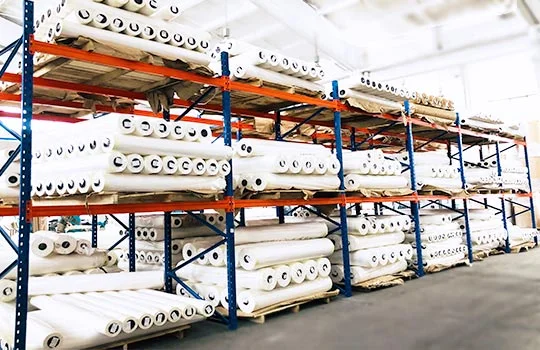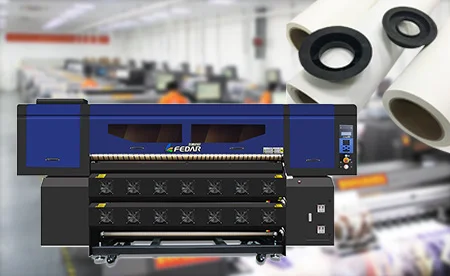HOT SALE
APPLICATION
Phone:+86-15215969856 E-Mail: 396838165@qq.com
Sublimating on tissue paper introduces a unique set of technical considerations. Unlike heavier substrates, tissue paper is lightweight and porous, making it both an opportunity and a challenge in custom packaging.
The Fundamentals of Sublimation on Tissue Paper
Sublimation on tissue paper is a total win for crafting bold, long-lasting, and head-turning custom packaging. With thin, low GSM tissue paper and the sharp precision of sublimation printing, you can whip up designs that make your brand pop. Here’s the lowdown on what makes this process tick, from the paper’s must-have traits to the tricky bits you’ll need to nail, and why it’s a killer choice for custom packaging.
Key Properties
For killer sublimation prints, your tissue paper’s gotta be thin but tough enough to handle the heat without ripping or getting all crinkly. Changfa Digital’s got 30GSM white and grey tissue paper, cut in widths from 160cm to 182cm with 1000m rolls. They’re perfect for sublimation, thanks to their smooth texture and just-right ink-soaking ability.
Challenges and Considerations
Low GSM tissue paper can be tricky—too much ink, and it’ll bleed, warp, or ghost if you’re not careful. You gotta dial in the heat, pressure, and ink amount just right. Plus, since the substrate’s kinda see-through, you need to watch your colors closely to keep prints from looking faded.
Why Sublimation is Ideal for Custom Packaging
Even with its quirks, sublimation’s a go-to for custom packaging. It pumps out bright, full-color designs that sink right into the material. No smudging, super durable—perfect for branded inserts or wraps that stick in folks’ minds.
Essential Equipment and Materials
Achieving high-quality sublimation on tissue paper depends heavily on your choice of equipment and consumables. Each component must be compatible with delicate substrates like tissue.
Choosing the Right Sublimation Printer and Ink
For precision printing on thin media, you need an inkjet printer that delivers fine resolution with stable ink flow. A reliable option is the High Quality CMYK Digital Color Printing Machine Digital Fabric Printer (Model-Xplus-8). It supports a max print width of 1900mm and delivers up to 120m²/h at 2PASS speed—ideal for large-scale runs without sacrificing detail.
Sublimation inks used should have excellent fluency—360dpi continuous printing over 20 meters without clogging—and should be environmentally friendly with wide color gamut coverage.
Selecting Compatible Tissue Paper Types
Not all tissue papers are created equal. Changfa Digital manufactures various GSM options starting from as low as 29GSM up to 100GSM. For sublimation purposes, their 30GSM white or grey papers are specifically formulated as protect/tissue paper, ensuring smooth transfer and minimal distortion under heat.
Heat Press Requirements for Consistent Transfer
A flatbed heat press with adjustable temperature and pressure settings is critical. Lightweight substrates require lower pressure but precise temperature control (typically between 180–200°C) to avoid scorching while ensuring full dye activation.
Optimizing Design and Color Management
Your design workflow must anticipate the behavior of inks on thin substrates. This involves both software preparation and hardware calibration. Use ICC profiles tailored for sublimation printers and specific ink sets. This ensures colors appear accurately once transferred—even through semi-translucent media like tissue paper. Because tissue can shift slightly during pressing, include sufficient bleed in your artwork. Avoid ultra-fine lines or excessive transparency layers as they may not render cleanly due to ink spread on porous surfaces.
Color density must be balanced; oversaturation leads to bleed-through while undersaturation causes faded prints. Testing with your chosen printer—such as the Model-Xplus-8 fabric printer—will help calibrate settings per substrate type.
Process to Sublimate on Tissue Paper Effectively
Mastering each phase ensures repeatable quality whether you’re producing samples or scaling up production.
Pre-Treatment and Handling of Tissue Paper
While pre-treatment isn’t always necessary, keeping tissue dry and flat before printing helps prevent curling or misalignment during heat pressing. Store rolls in a humidity-controlled environment (ideally around 50%).
Printing Techniques to Minimize Wrinkling and Ink Bleed
Use tension-controlled feeding systems when printing from rolls. Reduce ink density slightly compared to textiles; this prevents over-saturation which leads to bleeding through the thin fibers of tissue paper.
Heat Transfer Application Settings
The sweet spot lies around 180°C–190°C for about 15–25 seconds using light pressure. These parameters ensure complete dye sublimation without damaging fragile fibers or distorting fine details.
Troubleshooting Common Issues
Even with ideal conditions, issues may arise that require quick diagnosis and correction.
Preventing Ghosting, Smudging, and Warping During Transfer
Ghosting often results from movement between print and press phases—use tacky adhesive sprays sparingly or place weight edges before pressing. Warping may indicate excessive heat or moisture retention; allow cooling time post-transfer before handling.
Addressing Ink Migration and Color Fading Over Time
Low-quality inks can migrate into adjacent areas over time or fade under UV exposure. Using high-density sublimation inks tested at sunproof level 6 and washproof level 4–5 ensures long-lasting vibrancy even under varying conditions.
Enhancing Efficiency in Production Workflows
When scaling production beyond small batches, automation becomes essential for consistency and throughput.
Integrating Automated Feeding Systems
Roll-to-roll systems paired with high-speed printers like the Xplus-8 streamline operations by reducing manual handling errors while maintaining tight registration across long print jobs.
Quality Control Measures
Implement visual inspection checkpoints post-printing and post-transfer phases to catch defects early. Use calibrated colorimeters periodically to ensure color consistency across batches.
Sustainable Practices in Sublimating on Tissue Paper
Eco-conscious production matters more than ever—and sublimation can align well with sustainability goals when done right. Sublimation inks from Changfa Digital adopt environmentally friendly solvents that are safe and non-toxic. When combined with biodegradable low-GSM tissues such as their 30GSM white/grey papers, your packaging solutions become both eye-catching and eco-responsible.
Strategic Applications of Customized Sublimated Tissue Paper
Custom printed tissue adds perceived value across industries while reinforcing brand identity subtly yet effectively.
Branding Opportunities Through Packaging Inserts and Wraps
Tissue inserts printed with logos or seasonal patterns elevate unboxing experiences—especially in luxury goods where every detail counts toward brand perception.
Industry Use Cases: Fashion, Cosmetics, Tech Accessories
Fashion brands wrap garments delicately in logo-stamped tissues; cosmetics companies use them inside boxes as protective liners; tech accessories benefit from elegant branded cushioning—all made possible by sublimated tissue solutions tailored per industry needs.
Choosing the Right Partner for Equipment and Support
Your success hinges not just on tools but also expert guidance throughout your journey into custom sublimation packaging solutions.
Specialized Suppliers–Changfa Digital
Changfa Digital has been delivering professional-grade digital printing services globally for over 15 years. They are the factory behind it all—from base paper manufacturing through coating lines to slitting workshops—with a monthly output reaching up to 3000 tons. Their infrastructure includes four coating lines imported from Germany plus ten slitting machines dedicated solely to roll conversion—a testament to their scale readiness. With OEM/ODM customization available along with round-the-clock support services, you gain more than a vendor—you gain a partner invested in your growth.
FAQ
Q: What GSM is best when I want to sublimate on tissue paper?
A: For sublimation applications requiring flexibility yet durability, using 30GSM white or grey tissue papers offered by Changfa Digital provides excellent results without compromising print quality during heat transfer processes.
Q: How do I prevent ghosting during heat pressing?
A: Ensure no movement occurs between printed sheet placement and pressing stage; use light adhesive sprays if necessary or apply weights gently at corners before closing the press lid.
Q: Can I automate my workflow when producing large volumes of custom printed tissues?
A: Yes. Pairing automated feeding systems with high-speed printers like the Model-Xplus-8 digital fabric printer enables efficient large-run production while maintaining alignment accuracy across rolls.









